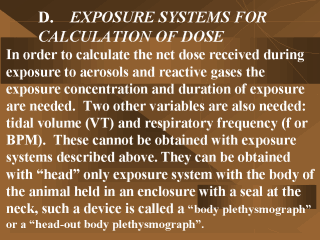| front |1 |2 |3 |4 |5 |6 |7 |8 |9 |10 |11 |12 |13 |14 |15 |16 |17 |18 |19 |20 |21 |22 |23 |24 |25 |26 |review |
 |
A
plethysmograph is an instrument for measuring and recording the variation in volume of a
part of the body; it consists of a closed vessel surrounding the part of the body and
connected with a means of measuring its displacement. For a “body plethysmograph”
thoracic volume displacement is measured (proportional to tidal volume) since a seal is
imposed at the neck of the animal. The volume displacement can be measured in two ways. A pressure transducer is attached directly to a port on the plethysmograph; the change in pressure created with each breath will be proportional to the change in volume. A pneumotachograph, to which a differential pressure transducer is attached, is connected to a port on the plethysmograph. For further details on plethysmographs, see Alarie, Y., Iwasaki, I. and Schaper, M. Whole body plethysmography in sedentary or exercise conditions to determine pulmonary toxicity, including hypersensitivity induced by airborne chemicals. J. Am. Coll. Toxicol. 9, 407-439, 1990. |